Tutorial 3: Combining determinism and stochasticity#
Week 2, Day 2: Linear Systems
By Neuromatch Academy
Content Creators: Bing Wen Brunton, Alice Schwarze, Biraj Pandey
Content Reviewers: Norma Kuhn, John Butler, Matthew Krause, Ella Batty, Richard Gao, Michael Waskom
Production editors: Gagana B, Spiros Chavlis
Tutorial Objectives#
Estimated timing of tutorial: 45 minutes
Time-dependent processes rule the world.
Now that we’ve spent some time familiarizing ourselves with the behavior of such systems when their trajectories are (1) entirely predictable and deterministic, or (2) governed by random processes, it’s time to consider that neither is sufficient to describe neuroscience. Instead, we are often faced with processes for which we know some dynamics, but there are some random aspects as well. We call these dynamical systems with stochasticity.
This tutorial will build on our knowledge and gain some intuition for how deterministic and stochastic processes can both be a part of a dynamical system by:
Simulating random walks
Investigating the mean and variance of a Ornstein-Uhlenbeck (OU) process
Quantifying the OU process’s behavior at equilibrium.
Setup#
Install and import feedback gadget#
Show code cell source
# @title Install and import feedback gadget
!pip3 install vibecheck datatops --quiet
from vibecheck import DatatopsContentReviewContainer
def content_review(notebook_section: str):
return DatatopsContentReviewContainer(
"", # No text prompt
notebook_section,
{
"url": "https://pmyvdlilci.execute-api.us-east-1.amazonaws.com/klab",
"name": "neuromatch_cn",
"user_key": "y1x3mpx5",
},
).render()
feedback_prefix = "W2D2_T3"
# Imports
import numpy as np
import matplotlib.pyplot as plt
Figure Settings#
Show code cell source
# @title Figure Settings
import logging
logging.getLogger('matplotlib.font_manager').disabled = True
import ipywidgets as widgets # interactive display
%config InlineBackend.figure_format = 'retina'
plt.style.use("https://raw.githubusercontent.com/NeuromatchAcademy/course-content/main/nma.mplstyle")
Plotting Functions#
Show code cell source
# @title Plotting Functions
def plot_random_walk_sims(sims, nsims=10):
"""Helper for exercise 3A"""
plt.figure()
plt.plot(sim[:nsims, :].T)
plt.xlabel('time')
plt.ylabel('position x')
plt.show()
def plot_mean_var_by_timestep(mu, var):
"""Helper function for exercise 3A.2"""
fig, (ah1, ah2) = plt.subplots(2)
# plot mean of distribution as a function of time
ah1.plot(mu)
ah1.set(ylabel='mean')
ah1.set_ylim([-5, 5])
# plot variance of distribution as a function of time
ah2.plot(var)
ah2.set(xlabel='time')
ah2.set(ylabel='variance')
plt.show()
def plot_ddm(t, x, xinfty, lam, x0):
plt.figure()
plt.plot(t, xinfty * (1 - lam**t) + x0 * lam**t, 'r',
label='deterministic solution')
plt.plot(t, x, 'k.', label='simulation') # simulated data pts
plt.xlabel('t')
plt.ylabel('x')
plt.legend()
plt.show()
def var_comparison_plot(empirical, analytical):
plt.figure()
plt.plot(empirical, analytical, '.', markersize=15)
plt.xlabel('empirical equilibrium variance')
plt.ylabel('analytic equilibrium variance')
plt.plot(np.arange(8), np.arange(8), 'k', label='45 deg line')
plt.legend()
plt.grid(True)
plt.show()
def plot_dynamics(x, t, lam, xinfty=0):
""" Plot the dynamics """
plt.figure()
plt.title('$\lambda=%0.1f$' % lam, fontsize=16)
x0 = x[0]
plt.plot(t, xinfty + (x0 - xinfty) * lam**t, 'r', label='analytic solution')
plt.plot(t, x, 'k.', label='simulation') # simulated data pts
plt.ylim(0, x0+1)
plt.xlabel('t')
plt.ylabel('x')
plt.legend()
plt.show()
Section 1: Random Walks#
Video 1: E. coli and Random Walks#
Submit your feedback#
Show code cell source
# @title Submit your feedback
content_review(f"{feedback_prefix}_Ecoli_and_Random_Walks_Video")
To begin, let’s first take a gander at how life sometimes wanders around aimlessly. One of the simplest and best-studied living systems that has some interesting behaviors is the E. coli bacterium, which is capable of navigating odor gradients on a substrate to seek a food source. Larger life (including flies, dogs, and blindfolded humans) sometimes use the same strategies to guide their decisions.
Here, we will consider what the E. coli does in the absence of food odors. What’s the best strategy when one does not know where to head? Why, flail around randomly, of course!
The random walk is exactly that — at every time step, use a random process like flipping a coin to change one’s heading accordingly. Note that this process is closely related to Brownian motion, so you may sometimes hear that terminology used as well.
Let’s start with a one-dimensional random walk. A bacterium starts at \(x=0\). At every time step, it flips a coin (a very small, microscopic coin of protein mintage), then heads left \(\Delta x = -1\) or right \(\Delta x = +1\) for with equal probability. For instance, if at time step \(1\) the result of the coin flip is to head right, then its position at that time step becomes \(x_1 = x_0 + \Delta x = 1.\) Continuing in this way, its position at time step \(k+1\) is given by
We will simulate this process below and plot the position of the bacterium as a function of the time step.
Execute to simulate and visualize a random walk
Show code cell source
# @markdown Execute to simulate and visualize a random walk
# parameters of simulation
T = 100
t = np.arange(T)
x = np.zeros_like(t)
np.random.seed(2020) # set random seed
# initial position
x[0] = 0
# step forward in time
for k in range(len(t)-1):
# choose randomly between -1 and 1 (coin flip)
this_step = np.random.choice([-1,1])
# make the step
x[k+1] = x[k] + this_step
# plot this trajectory
plt.figure()
plt.step(t, x)
plt.xlabel('time')
plt.ylabel('position x')
plt.show()
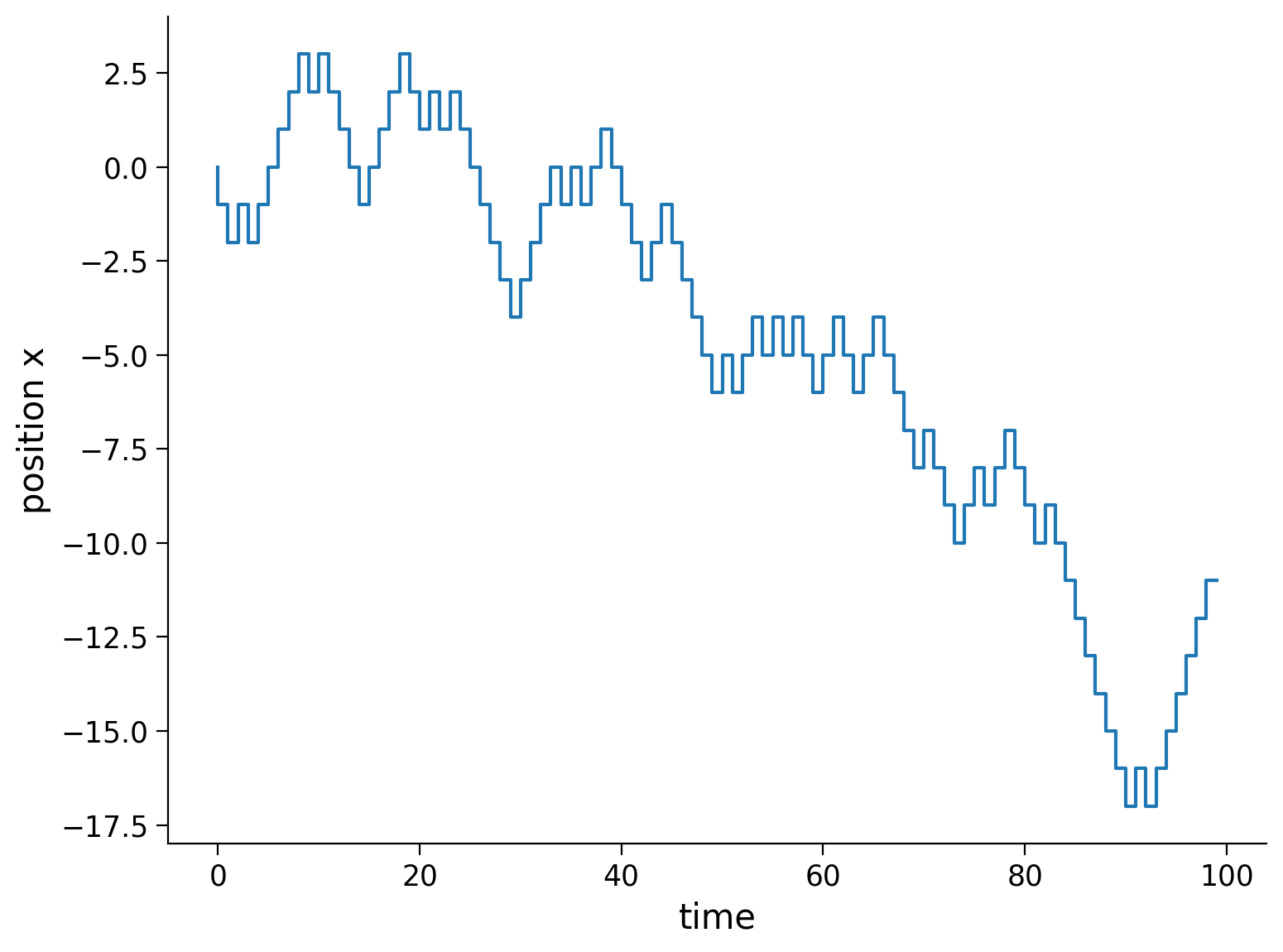
Coding Exercise 1A: Random walk simulation#
Referred to in video as exercise 3A
In the previous plot, we assumed that the bacterium takes a step of size \(1\) at every point in time. Let it take steps of different sizes!
We will code a random walk where the steps have a standard normal distribution (with mean \(\mu\) and standard deviation \(\sigma\)). Instead of running one trajectory at a time, we will write our code so that we can simulate a large number of trajectories efficiently. We will combine this all into a function random_walk_simulator that generates \(N\) random walks each with \(T\) time points efficiently.
We will plot 10 random walks for 10000 time steps each.
def random_walk_simulator(N, T, mu=0, sigma=1):
'''Simulate N random walks for T time points. At each time point, the step
is drawn from a Gaussian distribution with mean mu and standard deviation
sigma.
Args:
T (integer) : Duration of simulation in time steps
N (integer) : Number of random walks
mu (float) : mean of step distribution
sigma (float) : standard deviation of step distribution
Returns:
(numpy array) : NxT array in which each row corresponds to trajectory
'''
###############################################################################
## TODO: Code the simulated random steps to take
## Hints: you can generate all the random steps in one go in an N x T matrix
raise NotImplementedError('Complete random_walk_simulator_function')
###############################################################################
# generate all the random steps for all steps in all simulations in one go
# produces a N x T array
steps = np.random.normal(..., ..., size=(..., ...))
# compute the cumulative sum of all the steps over the time axis
sim = np.cumsum(steps, axis=1)
return sim
np.random.seed(2020) # set random seed
# simulate 1000 random walks for 10000 time steps
sim = random_walk_simulator(1000, 10000, mu=0, sigma=1)
# take a peek at the first 10 simulations
plot_random_walk_sims(sim, nsims=10)
Example output:
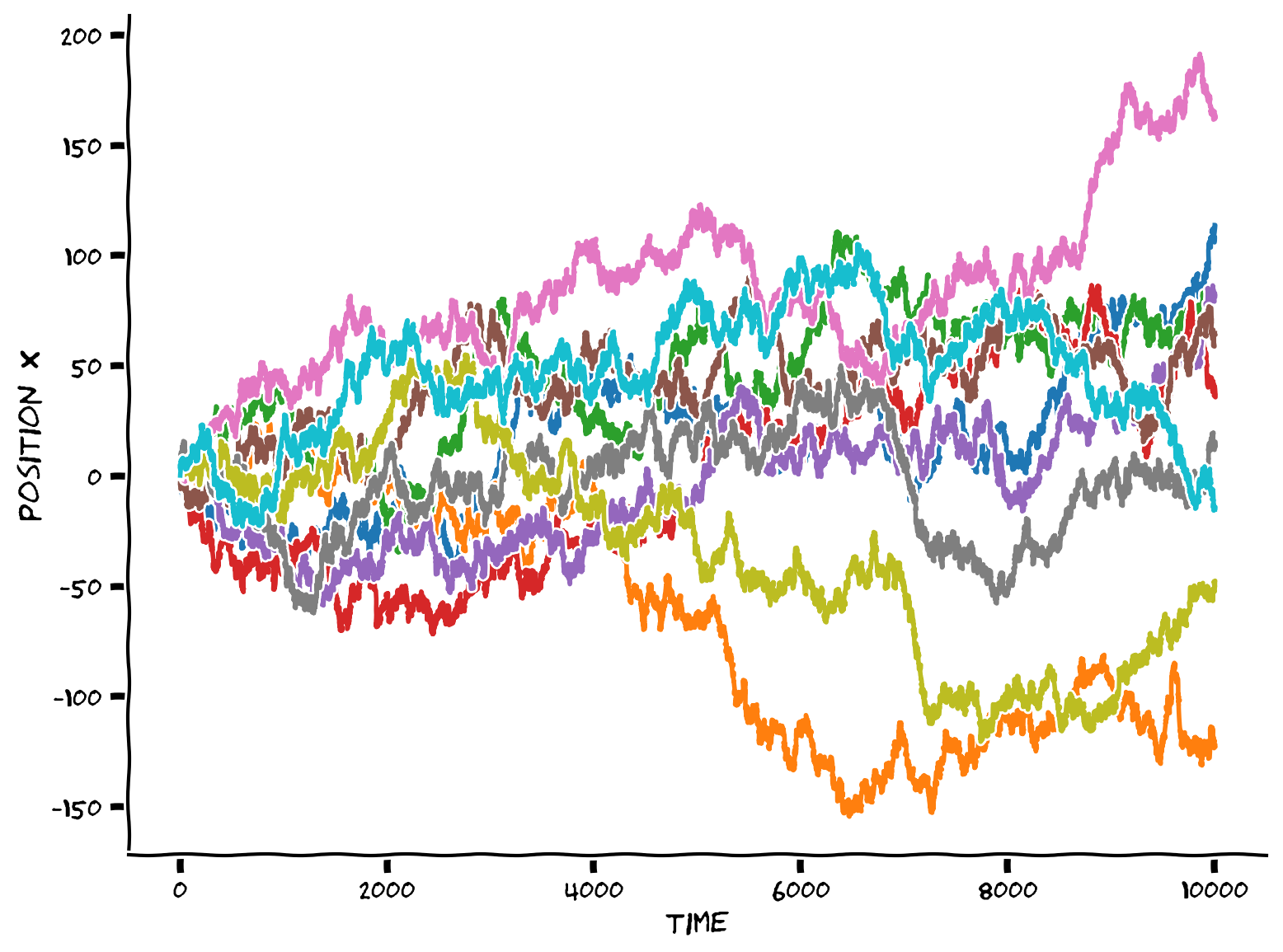
Submit your feedback#
Show code cell source
# @title Submit your feedback
content_review(f"{feedback_prefix}_Random_Walk_simulation_Exercise")
We see that the trajectories all look a little different from each other. But there are some general observations one can make: at the beginning almost all trajectories are very close to \(x=0\), which is where our bacterium started. As time progresses, some trajectories move further and further away from the starting point. However, a lot of trajectories stay close to the starting point of \(x=0\).
Now let’s take a look in the next cell at the distribution of bacteria positions at different points in time, analyzing all the trajectories we just generated above.
Execute to visualize distribution of bacteria positions
Show code cell source
# @markdown Execute to visualize distribution of bacteria positions
fig = plt.figure()
# look at the distribution of positions at different times
for i, t in enumerate([1000, 2500, 10000]):
# get mean and standard deviation of distribution at time t
mu = sim[:, t-1].mean()
sig2 = sim[:, t-1].std()
# make a plot label
mytitle = '$t=${time:d} ($\mu=${mu:.2f}, $\sigma=${var:.2f})'
# plot histogram
plt.hist(sim[:,t-1],
color=['blue','orange','black'][i],
# make sure the histograms have the same bins!
bins=np.arange(-300, 300, 20),
# make histograms a little see-through
alpha=0.6,
# draw second histogram behind the first one
zorder=3-i,
label=mytitle.format(time=t, mu=mu, var=sig2))
plt.xlabel('position x')
# plot range
plt.xlim([-500, 250])
# add legend
plt.legend(loc=2)
# add title
plt.title(r'Distribution of trajectory positions at time $t$')
plt.show()
At the beginning of the simulation, the distribution of positions is sharply peaked about \(0\). As time progresses, the distribution becomes wider but its center stays closer to \(0\). In other words, the mean of the distribution is independent of time, but the variance and standard deviation of the distribution scale with time. Such a process is called a diffusive process.
Coding Exercise 1B: Random walk mean & variance#
Compute and then plot the mean and variance of our bacterium’s random walk as a function of time.
# Simulate random walks
np.random.seed(2020) # set random seed
sim = random_walk_simulator(5000, 1000, mu=0, sigma=1)
##############################################################################
# TODO: Insert your code here to compute the mean and variance of trajectory positions
# at every time point:
raise NotImplementedError("Student exercise: need to compute mean and variance")
##############################################################################
# Compute mean
mu = ...
# Compute variance
var = ...
# Visualize
plot_mean_var_by_timestep(mu, var)
Example output:
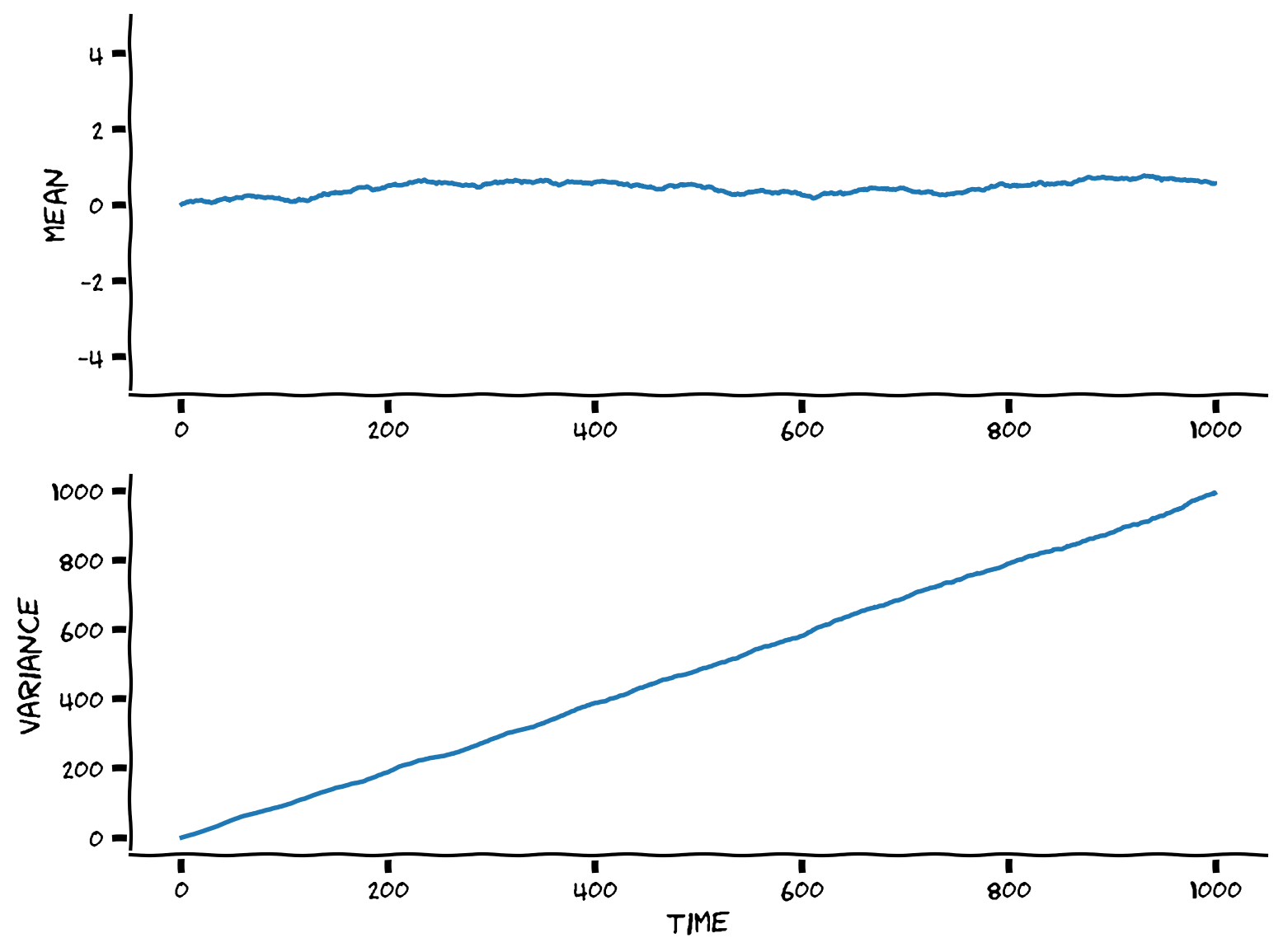
Submit your feedback#
Show code cell source
# @title Submit your feedback
content_review(f"{feedback_prefix}_Random_Walk_and_variance_Exercise")
The expected value of \(x\) stays close to 0, even for random walks of very long time. Cool!
The variance, on the other hand, clearly increases with time. In fact, the variance seems to increase linearly with time!
Interactive Demo 1: Influence of Parameter Choice#
How do the parameters \(\mu\) and \(\sigma\) of the Gaussian distribution from which we choose the steps affect the mean and variance of the bacterium’s random walk?
Make sure you execute this cell to enable the widget!
Show code cell source
# @markdown Make sure you execute this cell to enable the widget!
@widgets.interact
def plot_gaussian(mean=(-0.5, 0.5, .02), std=(.5, 10, .5)):
sim = random_walk_simulator(5000, 1000, mu=mean, sigma=std)
# compute the mean and variance of trajectory positions at every time point
mu = np.mean(sim, axis=0)
var = np.var(sim, axis=0)
# make a figure
fig, (ah1, ah2) = plt.subplots(2)
# plot mean of distribution as a function of time
ah1.plot(mu)
ah1.set(ylabel='mean')
# plot variance of distribution as a function of time
ah2.plot(var)
ah2.set(xlabel='time')
ah2.set(ylabel='variance')
plt.show()
Submit your feedback#
Show code cell source
# @title Submit your feedback
content_review(f"{feedback_prefix}_Influence_of_Parameter_Choice_Interactive_Demo_and_Discussion")
Section 2: The Ornstein-Uhlenbeck (OU) process#
Estimated timing to here from start of tutorial: 14 min
Video 2: Combining Deterministic & Stochastic Processes#
Submit your feedback#
Show code cell source
# @title Submit your feedback
content_review(f"{feedback_prefix}_Combining_Deterministic_and_Stochastic_Processes_Video")
The random walk process we just explored is diffusive, and the distribution of possible trajectories spreads, taking on increasing variance with time. Even so, at least in one dimension, the mean remains close to the initial value (in the example above, 0).
Our goal is now to build on this model to construct a drift-diffusion model (DDM). DDM is a popular model for memory, which as we all know, is often an exercise in hanging on to a value imperfectly. Decision-making and memory will be the topic for tomorrow, so here we build the mathematical foundations and develop some intuition for how such systems behave!
To build such a model, let’s combine the random walk model with the first differential equations we explored in Tutorial 1 earlier. Although those models had been written in continuous time as \(\dot{x} = a x\), here let’s consider the discrete version of the same system and write:
\(x_{k+1} = \lambda x_k\),
whose solution can be written as
\(x_k = x_0 \lambda^k\),
where \(x_0\) is the value of \(x\) at time \(t=0\).
Now, let’s simulate and plot the solution of the discrete version of our first differential equation from Tutorial 1 below. Run the code below.
# parameters
lam = 0.9
T = 100 # total Time duration in steps
x0 = 4. # initial condition of x at time 0
# initialize variables
t = np.arange(0, T, 1.)
x = np.zeros_like(t)
x[0] = x0
# Step through in time
for k in range(len(t)-1):
x[k+1] = lam * x[k]
# plot x as it evolves in time
plot_dynamics(x, t, lam)
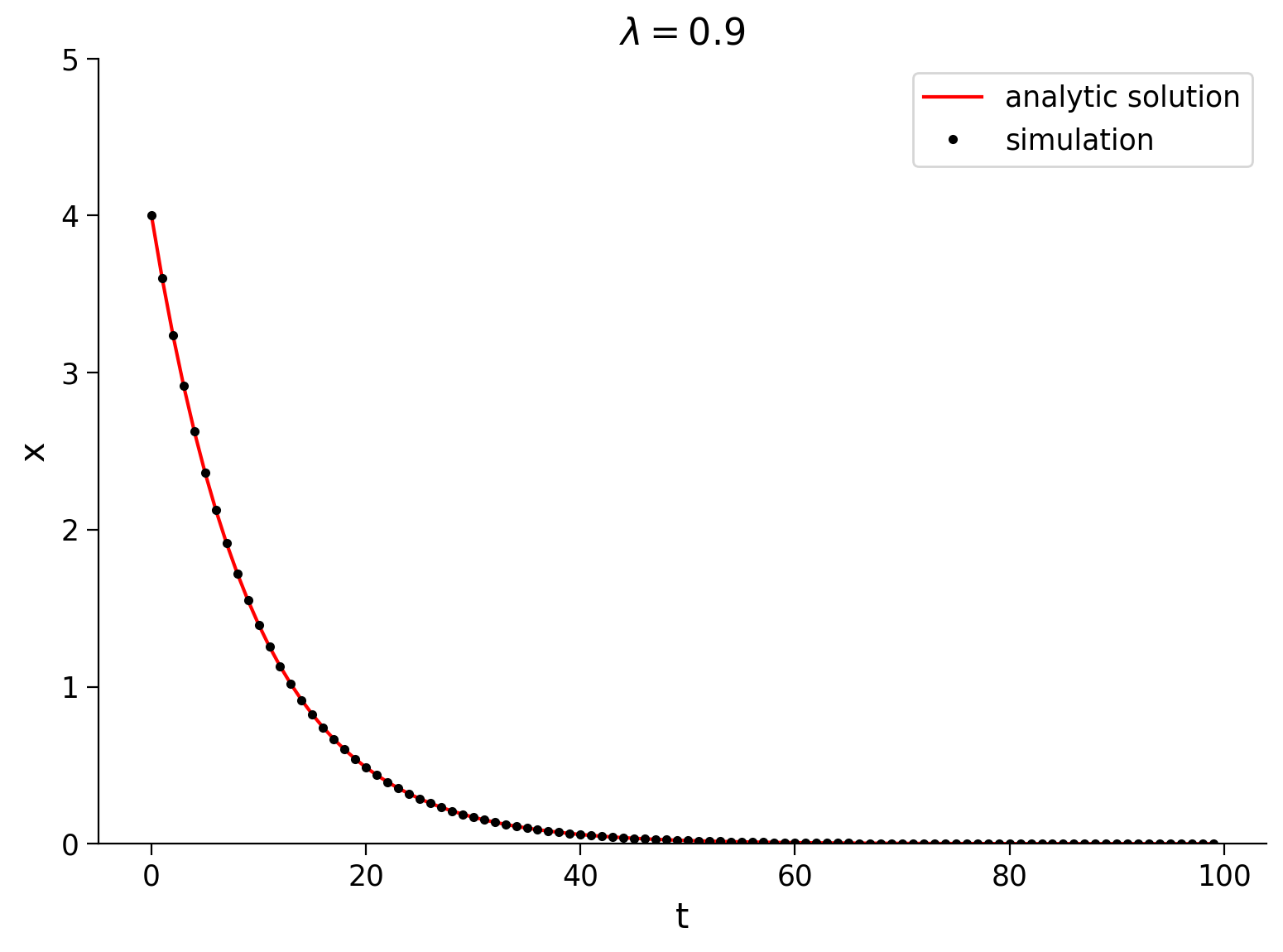
Notice that this process decays towards position \(x=0\). We can make it decay towards any position by adding another parameter \(x_\infty\). The rate of decay is proportional to the difference between \(x\) and \(x_\infty\). Our new system is
We have to modify our analytic solution slightly to take this into account:
Let’s simulate and plot the dynamics of this process below. Hopefully, we see that it start at \(x_0\) and decay towards \(x_{\infty}.\)
# parameters
lam = 0.9 # decay rate
T = 100 # total Time duration in steps
x0 = 4. # initial condition of x at time 0
xinfty = 1. # x drifts towards this value in long time
# initialize variables
t = np.arange(0, T, 1.)
x = np.zeros_like(t)
x[0] = x0
# Step through in time
for k in range(len(t)-1):
x[k+1] = xinfty + lam * (x[k] - xinfty)
# plot x as it evolves in time
plot_dynamics(x, t, lam, xinfty)
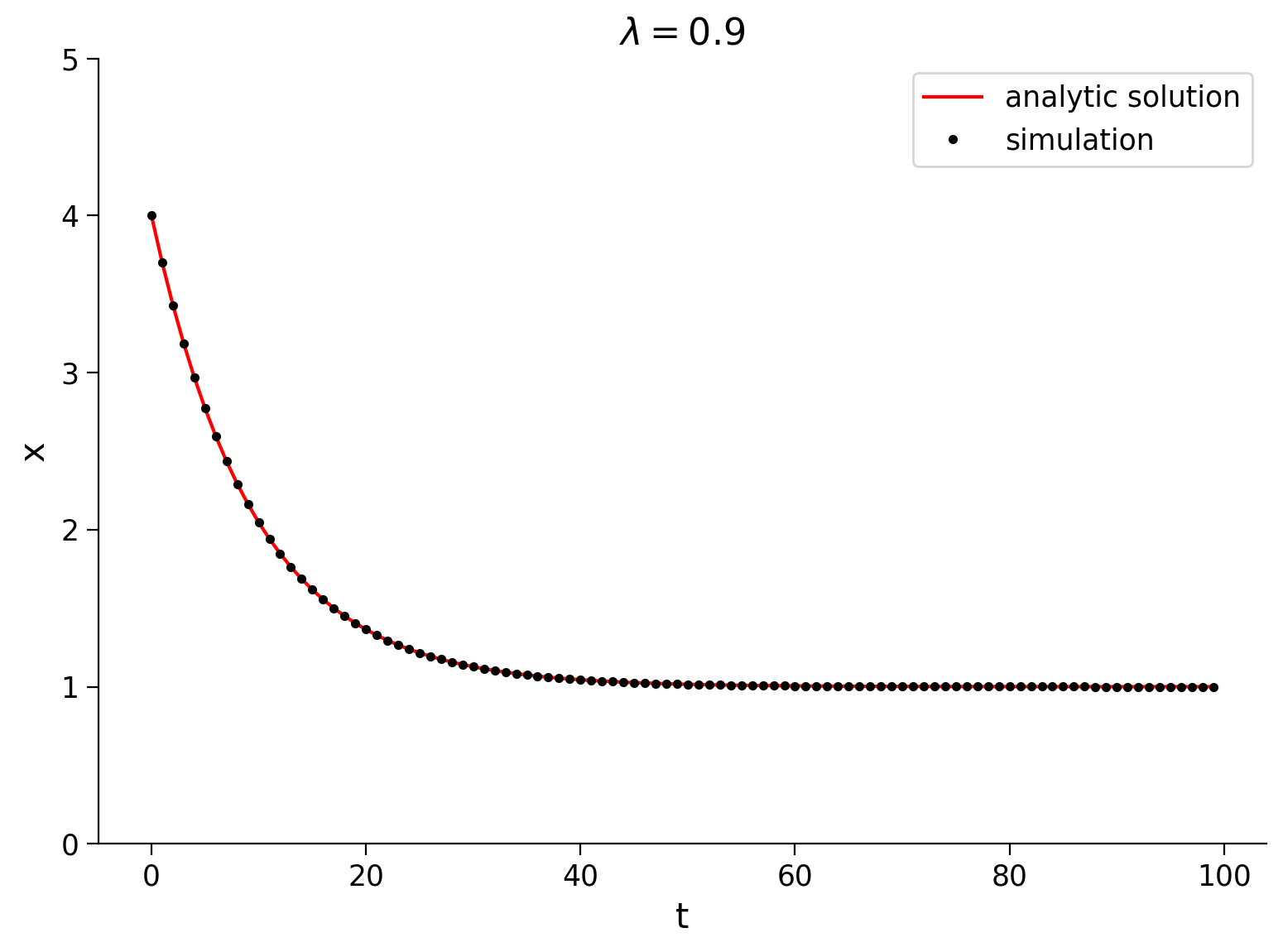
Now we are ready to take this basic, deterministic difference equation and add a diffusion process on top of it! Fun times in Python land.
As a point of terminology: this type of process is commonly known as a drift-diffusion model or Ornstein-Uhlenbeck (OU) process. The model is a combination of a drift term toward \(x_{\infty}\) and a diffusion term that walks randomly. You may sometimes see them written as continuous stochastic differential equations, but here we are doing the discrete version to maintain continuity in the tutorial. The discrete version of our OU process has the following form:
where \(\eta\) is sampled from a standard normal distribution (\(\mu=0, \sigma=1\)).
Coding Exercise 2: Drift-diffusion model#
Modify the code below so that each step through time has a deterministic part (hint: exactly like the code above) plus a random, diffusive part that is drawn from from a normal distribution with standard deviation of \(\sigma\) (sig in the code). It will plot the dynamics of this process.
def simulate_ddm(lam, sig, x0, xinfty, T):
"""
Simulate the drift-diffusion model with given parameters and initial condition.
Args:
lam (scalar): decay rate
sig (scalar): standard deviation of normal distribution
x0 (scalar): initial condition (x at time 0)
xinfty (scalar): drift towards convergence in the limit
T (scalar): total duration of the simulation (in steps)
Returns:
ndarray, ndarray: `x` for all simulation steps and the time `t` at each step
"""
# initialize variables
t = np.arange(0, T, 1.)
x = np.zeros_like(t)
x[0] = x0
# Step through in time
for k in range(len(t)-1):
##############################################################################
## TODO: Insert your code below then remove
raise NotImplementedError("Student exercise: need to implement simulation")
##############################################################################
# update x at time k+1 with a deterministic and a stochastic component
# hint: the deterministic component will be like above, and
# the stochastic component is drawn from a scaled normal distribution
x[k+1] = ...
return t, x
lam = 0.9 # decay rate
sig = 0.1 # standard deviation of diffusive process
T = 500 # total Time duration in steps
x0 = 4. # initial condition of x at time 0
xinfty = 1. # x drifts towards this value in long time
# Plot x as it evolves in time
np.random.seed(2020)
t, x = simulate_ddm(lam, sig, x0, xinfty, T)
plot_ddm(t, x, xinfty, lam, x0)
Example output:
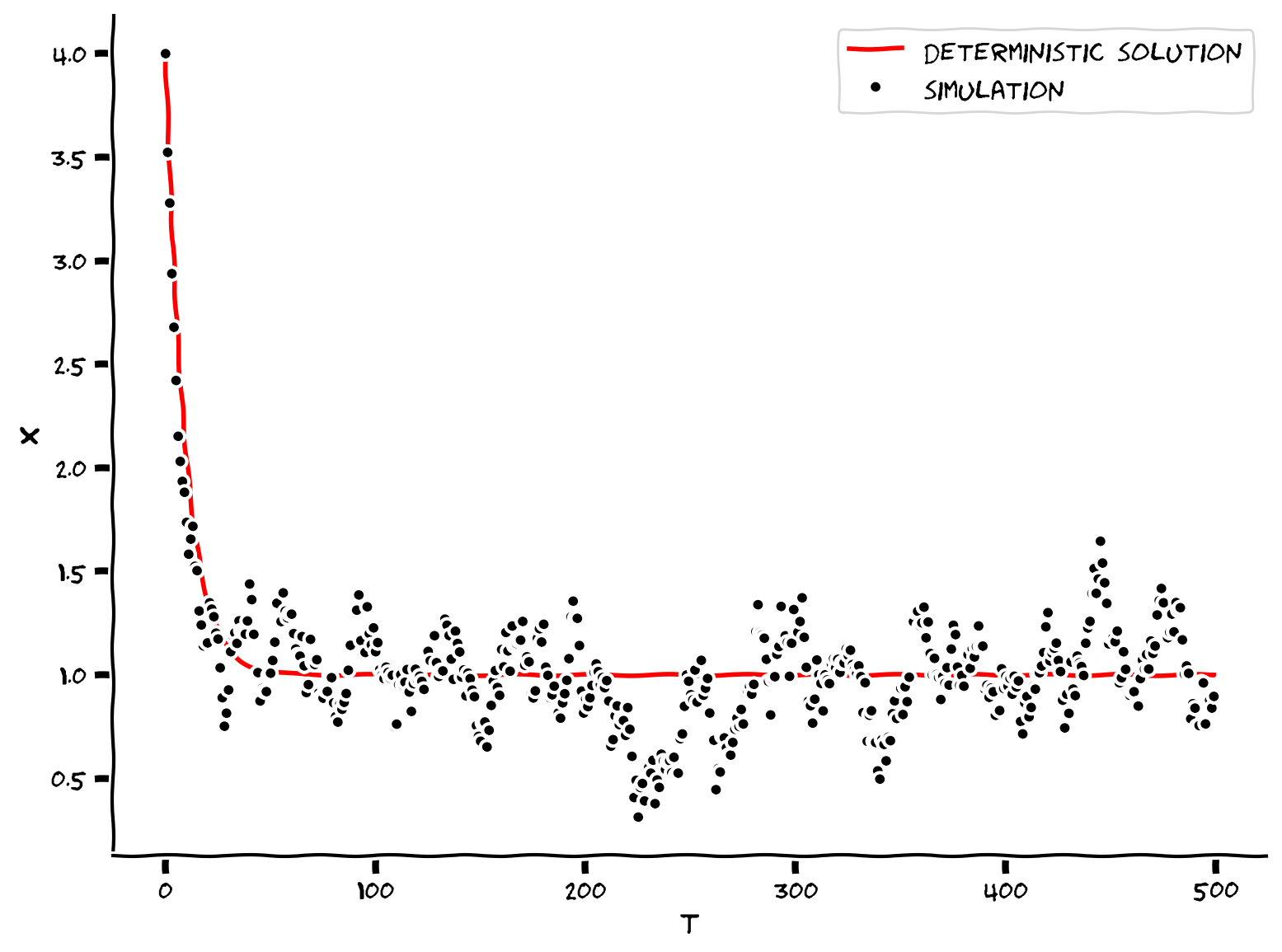
Submit your feedback#
Show code cell source
# @title Submit your feedback
content_review(f"{feedback_prefix}_DriftDiffusion_model_Exercise")
Think! 2: Drift-Diffusion Simulation Observations#
Describe the behavior of your simulation by making some observations. How does it compare to the deterministic solution? How does it behave in the beginning of the stimulation? At the end?
Submit your feedback#
Show code cell source
# @title Submit your feedback
content_review(f"{feedback_prefix}_DriftDiffusion_Simulation_Observations_Discussion")
Section 3: Variance of the OU process#
Estimated timing to here from start of tutorial: 35 min
Video 3: Balance of Variances#
Submit your feedback#
Show code cell source
# @title Submit your feedback
content_review(f"{feedback_prefix}_Balance_of_Variances_Video")
As we can see, the mean of the process follows the solution to the deterministic part of the governing equation. So far, so good!
But what about the variance?
Unlike the random walk, because there’s a decay process that “pulls” \(x\) back towards \(x_\infty\), the variance does not grow without bound with large \(t\). Instead, when it gets far from \(x_\infty\), the position of \(x\) is restored, until an equilibrium is reached.
The equilibrium variance for our drift-diffusion system is
Notice that the value of this equilibrium variance depends on \(\lambda\) and \(\sigma\). It does not depend on \(x_0\) and \(x_\infty\).
To convince ourselves that things are behaving sensibly, let’s compare the empirical variances of the equilibrium solution to the OU equations with the expected formula.
Coding Exercise 3: Computing the variances empirically#
Write code to compute the analytical variance: \(\text{Var} = \frac{\sigma^2}{1 - \lambda^2}\), and compare against the empirical variances (which is already provided for you using the helper function). You should see that they should be about equal to each other and lie close to the 45 degree (\(y=x\)) line.
def ddm(T, x0, xinfty, lam, sig):
t = np.arange(0, T, 1.)
x = np.zeros_like(t)
x[0] = x0
for k in range(len(t)-1):
x[k+1] = xinfty + lam * (x[k] - xinfty) + sig * np.random.standard_normal(size=1)
return t, x
# computes equilibrium variance of ddm
# returns variance
def ddm_eq_var(T, x0, xinfty, lam, sig):
t, x = ddm(T, x0, xinfty, lam, sig)
# returns variance of the second half of the simulation
# this is a hack: assumes system has settled by second half
return x[-round(T/2):].var()
np.random.seed(2020) # set random seed
# sweep through values for lambda
lambdas = np.arange(0.05, 0.95, 0.01)
empirical_variances = np.zeros_like(lambdas)
analytical_variances = np.zeros_like(lambdas)
sig = 0.87
# compute empirical equilibrium variance
for i, lam in enumerate(lambdas):
empirical_variances[i] = ddm_eq_var(5000, x0, xinfty, lambdas[i], sig)
##############################################################################
## Insert your code below to calculate the analytical variances
raise NotImplementedError("Student exercise: need to compute variances")
##############################################################################
# Hint: you can also do this in one line outside the loop!
analytical_variances = ...
# Plot the empirical variance vs analytical variance
var_comparison_plot(empirical_variances, analytical_variances)
Example output:

Submit your feedback#
Show code cell source
# @title Submit your feedback
content_review(f"{feedback_prefix}_Computing_the_variances_empirically_Exercise")
Summary#
Estimated timing of tutorial: 45 minutes
In this tutorial, we have built and observed OU systems, which have both deterministic and stochastic parts. We see that they behave, on average, similar to our expectations from analyzing deterministic dynamical systems.
Importantly, the interplay between the deterministic and stochastic parts serve to balance the tendency of purely stochastic processes (like the random walk) to increase in variance over time. This behavior is one of the properties of OU systems that make them popular choices for modeling cognitive functions, including short-term memory and decision-making.

